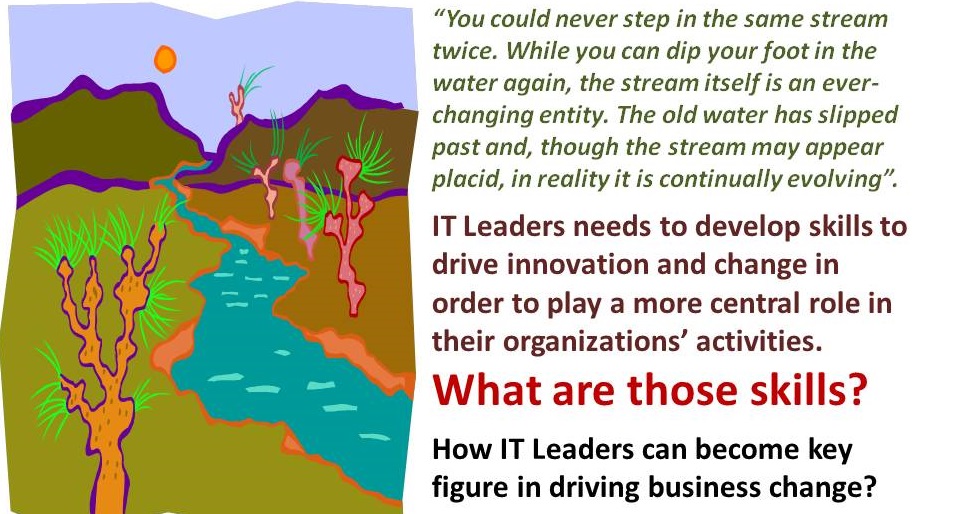- Home
- Business Processes
- Industry Knowledge
- Aerospace Industry
- Automotive Industry
- Banking Domain
- BFSI Industry
- Consumer/ FMCG Industry
- Chemicals Industry
- Engineering & Construction
- Energy Industry
- Education Domain
- Finance Domain
- Hospitality Domain
- Healthcare Industry
- Insurance Domain
- Retail Industry
- Travel and Tourism Domain
- Telecom Industry
- Leadership Skills
- eLearning
- Home
- Leadership
- Career Management
- Change is the Only Constant
Change is the Only Constant
In our present Hitech scenario, society is changing very fast. What are the skills that are most relevant for leaders in relation to the changing economic environment? Leaders need to develop skills to drive innovation and change in order to play a more central role in their organizations’ activities. How do managers accept the change and meet business expectations by becoming a key figure in driving change and innovation?
Change is Happening Every Minute
The ancient Greek philosopher Heraclitus once observed that you could never step in the same stream twice. While you can dip your foot in the water again, the stream itself is an ever-changing entity. The old water has slipped past and, though the stream may appear placid, in reality, it is continually evolving. You all know that the stream changes all day, every day. You might say it changes twenty-four cross seven,” every passing second.
If you look around, you will find that ten years ago the face of the world was quite different from what we are familiar with today, and ten years from now, the world will be totally different from what it is today. The same principle is applicable to each and every being. This is because change is a natural, universal, and inevitable social phenomenon. If one wants to know at what rate society is changing, the correct answer will be at the click of the mouse. Change, since time immemorial, has affected each and every aspect of human life, whether it is a lifestyle, food habits, thought processes, language, art, relationship, religion, family, marriage, systems of society (political, economic, legal, and administrative), etc. What is important to note is whether the change is leading towards a positive end or not. Is change helping society in extension or development, or is the outcome just the reverse?
Concept of Social & Cultural Change
We need to understand that there are two types of processes that work in society - one which sustains the social system, and, the other, which brings about change in the system.
The first process may be termed, conformity, or, status quo.
The latter may be called the process of cultural and social change. In simple terms, change denotes a difference in anything observed over a period of time. Similarly, social change means observable differences in any social phenomenon over a period of time, and cultural change means observable differences in any cultural phenomenon over a period of time.
Meaning of Change
The dictionary meaning of change as a noun is making or becoming different, different from the previous state, the substitution of one for another variation, etc. Change as a verb means to undergo change, to make or become different. Change essentially implies dissatisfaction with the old and the urge for the new. Change underlies a qualitatively different way of perceiving, thinking, and behaving to improve over the past and existing practices.
The Characteristics of Change
After understanding the definition of change it is also very important to understand the nature and characteristics of change. The main characteristics of change are given below
- Change can be seen as continuous and intrinsic to an organization or as extrinsic and discontinuous.
- Change can be patterned and predictable or complex and unpredictable.
- Change is dual or bipolar.
- Continuity without change leads to stagnation, frustration, and boredom in individuals and ambiguity, conflict, and degenerative pathology in individuals and organizations.
- Many times, the rate of change is faster than our ability to comprehend and cope with it.
- Change is universal
- The speed and rate of change are relative, it differs from society to society, and from time to time.
- Social change is community change, which occurs in the life of the entire community.
- Change is a law of nature. It is natural. It can occur either in the natural course, or, as a result of planned efforts.
- One change can lead to many changes in a chain-reaction sequence.

The Meaning of Organizational Change
The term "change" refers to any alteration which occurs in the overall work environment of an organization. According to Robbins change means making things different. We are familiar with changes brought about by the twin phenomena of liberalization and globalization in all walks of life. The banking sector has adapted to the emerging scenario very fast. And the power sector is now beginning to respond to these trends. Change results from the pressure of forces, which are both inside and outside the organization.
Internal Forces
Change is continuous and intrinsic to an organization: There are changes in an organization that are minute in nature but take place continuously. An organization may be perceived as being in a state of flux (like the universe) and the elements of its systems and sub-systems always undergo subtle changes (incremental changes). Certain changes occurring inside the organization are very minute and their impact is hardly felt.
External Forces
Change as extrinsic and discontinuous: Organisations are perceived as normally stable and change is perceived as disruptive, forcing organizations to modify, restructure, or reconfigure. A few changes are cataclysmic in nature, giving the organization barely any time to cope with them. These are almost like natural calamities such as earthquakes, cyclones, etc. in their impact. Some organizations may handle changes in a creative manner or make drastic changes in their strategy and direction to emerge out of this turbulence whereas others may get lost in it.
The external forces like technology, nature of work, economic shocks, competitions, social trends, and politics necessitate a change in the internal organization. In some way or the other change influences, the whole organization as the subunits or various departments in an organization are interrelated and interdependent.
Usually, there are many changes occurring simultaneously in an organization. An effective management technique is thus required in order to deal with the changes.
Related Links
You May Also Like
-
Benefits of Teams in Workplace
The use of formal work teams is commonplace in modern organizations. But why we have teams? What are the benefits or advantages that teams provide for organizations and employees? Do we really need to adopt formal team structures and use team-building approaches in organizations? Read this article to explore and learn the benefits of having formal teams in organizations.
-
Charisma is a certain quality of an individual personality, by virtue of which he is set apart from ordinary men. Charismatic Leader gathers followers, through dint of personality and charm. Understand the meaning and concept of Charismatic Leadership and the qualities of a charismatic leader. Gain an understanding of the advantages and disadvantages of using charismatic leadership. Finally, explore the difference between charismatic and transformational leadership.
-
Evidence of the medically damaging symptoms of work stress necessitates applying the treatment of stress management. Stress management is increasingly drawing the attention to the management experts not only as a remedial measure but also as a way to resource management. If the workplace can be made a little more lovable the increase in the achievement of the organization may be much time more. If group stress can be removed by introducing group discussions and recreational facilities a long-lasting team spirit may get developed.
-
Four main areas in an organization that need special focus when we discuss the change in an organizational setup are organizational structure, technology, work environment, and the people. Some people call it a process, system, and people. Change in an organization includes adapting to change, controlling change, and effecting change.
-
Tools for Developing Your Team
If a manager has too many weak spots in the talent of the team, the ability to empower the team members to independently execute the project is impaired. Assignments fall behind schedule or stretch out because the needed skills or knowledge are not in place when needed. To successfully execute important projects, hiring talented people, and increasing the talents of existing staff are most important.
-
Listening is the foundation for good communication. It is also the hardest skill to master. Do you listen to confirm what you already know, or do you listen to explore and learn new things? How can we create receptive communication as a listener? The real art of listening involves awareness and sensitivity to the feelings of the speaker because it is at the feeling level that genuine connection, relationship, and healing occurs.
-
All the teams are dynamic in nature and they take time to come together, they form, develop, and grow in stages, over a period of time. Teams go through five progressive stages: Forming, Storming, Norming, Performing and Adjourning. In this article, we want to introduce you to these stages of team development and certain strategies that you can use to help the team grow and develop in each of these stages.
-
Reasons behind Wastage of Time
Under-utilization of time may be due to the faulty system or faults of manager/officer/leader or due to lack of planning. There could be many factors driving the procrastination behavior like system issues, personal work habits, and lack of delegation, personality traits, and bad working habits of the leader, failure to tackle interpersonal conflicts, obstacles, and lack of far-sightedness.
-
Recognizing Stress & its Sources
As an individual, you almost certainly know what stress feels like. Stressors are events or situations to which people must adjust. Stressors may be physical or psychological in nature. The level of severity of stress is determined not merely by exposure but the intensity, duration, and frequency of stressors. The sources of stress are many. They arise from multiple areas both with the individual and from the environment.
-
Creating Highly Effective Teams
How do we create effective teams? What comes to mind when you think about an effective team? High performing teams exhibit accountability, purpose, cohesiveness, and collaboration. It is a team that works seamlessly as a whole. Everyone brings unique talents and strengths and support each other to bring out the best in everyone. How do you create one?
Explore Our Free Training Articles or
Sign Up to Start With Our eLearning Courses

About Us
Learning
© 2023 TechnoFunc, All Rights Reserved










